Linguistic Copenhagen interpretation of Quantum language (����I�R�y���n�[�Q������; �ʎq���� (=QL))
Top News:
2025/12/06: [New paper] Kant Was Not Doing Epistemology A System-Theoretic Reinterpretation [https://zenodo.org/records/17840818] What Kant did was not that important.
2025/10/31: [New paper] Rethinking the Problem of Universals through a Quantum Language Approach [https://zenodo.org/records/17493379] The Problem of Universals is completely solved.
2025/8/11: [New paper] Fisher statistics should progress to quantum language [https://zenodo.org/records/16790955] Statistics should shift from a probabilistic understanding (which has continued for 100 years since Fisher) to a quantum understanding.
2025/7/12: [New paper] Rethinking Wittgenstein�fs Tractatus through Statistics and Quantum language [https://zenodo.org/records/15856099] Reading this will give you a complete understanding of Wittgenstein's Tractatus.
2025/5/28: [New paper] Axiomatic Bayesian Statistics and Quantum language [https://zenodo.org/records/15531322] From an axiomatic point of view, statistics is closer to von Neumann's quantum mechanics than to Kolmogorov's probability theory. This paper may be good. Even elementary school students can understand the Kalman filter.
2025/4/30: [New paper] Quantum Language for College Freshman: (1) Axiomatic Fisher Statistics [https://zenodo.org/records/15306903] My dream is to propose axiomatic statistics.
2025/4/11: [New paper] What Did Leibniz Intend to Say in His Correspondence with Clarke? [https://doi.org/10.5281/zenodo.15518807] is published. Leibniz's dream was made a reality by QL. I had different opinions from ChatGPT, so I removed him as a co-author.
2025/3/29: [New paper] Who is greatest, Plato or Aristotle? [https://zenodo.org/records/15518047] is published. This can be read without the knowledge of QL. It's probably a good paper since ChatGPT is a co-researcher. I think that Plato was greater.
2025/3/20: [New paper] Kant's transcendental idealism and statistics are closely related [https://doi.org/10.5281/zenodo.15272674] is published. This can be read without the knowledge of QL. It's probably a good paper since ChatGPT is a co-researcher.
Statistics has no philosophy. Kant's philosophy has no calculations. Therefore, "QL ⊃ Statistics + Kant" is the strongest.
[I]: The whole picture of Quantum Language (=QL=measurement theory) is explained in detail in the following two:
| [LCI]: | Linguistic Copenhagen interpretation of quantum mechanics: Quantum Language [Ver. 7] (2024) [https://philarchive.org/rec/ISHLCI-4] |
| [HWP]: | History of Western Philosophy from the quantum theoretical point of view; [Ver.6] [https://philarchive.org/rec/ISHHOW-4](2024) |
Therefore,
- Statistics, practical logic (= fuzzy logic), and quantum mechanics (Copenhagen interpretation) can be derived from QL
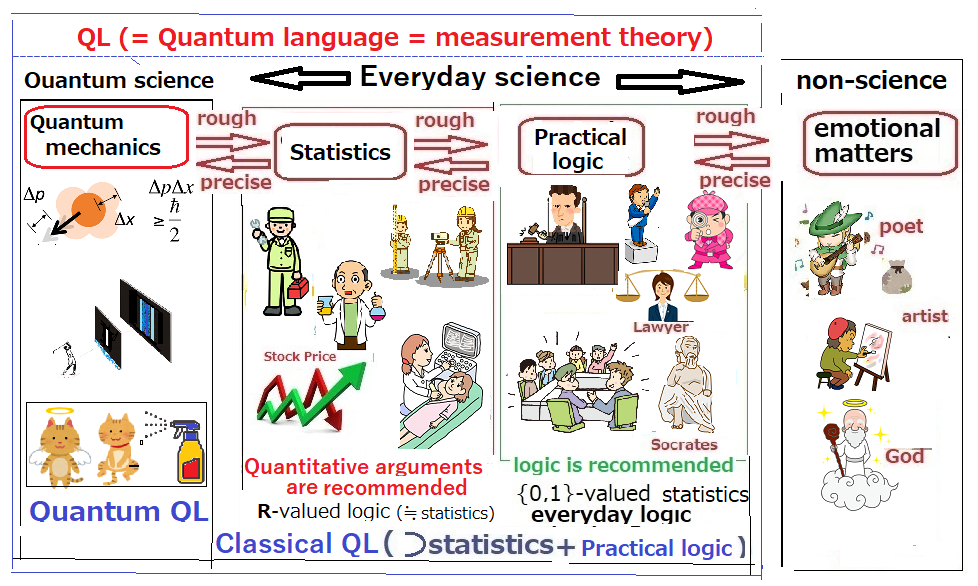
Figure 0: [classical QL(=everyday science)] $\supset$ [fuzzy logic] $\cup$[statistics]
However, this homepage is written so that it can be read without knowing [HWP] and [LCI].
======================================================
[II : Latest Results; The perfection of Socrates' absolutism.]:
This homepage will introduces the following latest paper:
| [SOC]: | History of Western Philosophy and QL (2024) [J. applied math. and Physics (Pdf download free)] |
Below is the Abstract:

-
[Abstract]: The purpose of philosophy is diverse, but many philosophers acknowledge that the mainstream of Western philosophy (Socrates, Plato, Aristotle, Thomas Aquinas, Descartes, Kant, Wittgenstein) has progressed towards the completion of Socrates' absolutism. However, can absolutism still maintain its central position after analytical philosophy? There are pessimistic views on this issue, like that of R. Rorty, a leading figure of neo-pragmatism. Recently, I have proposed quantum language (including quantum mechanics, statistics, fuzzy sets, etc.). I believe this theory is not only one of the most fundamental scientific theories but also the scientific ultimate endpoint of Western philosophy. If so, Socrates' dream has come true. The purpose of this paper is to discuss the above and convey to the reader that quantum language has the power to cause a paradigm shift from a classical mechanical worldview to a quantum mechanical worldview.
(I was a little disappointed to learn that some people misunderstand my assertion above as one result of the "philosophy of physics". As the diagram above [Socrates → Plato → .....→ Wittgenstein] shows that my research is in the mainstream of Western philosophy and is a challenge to the biggest unsolved problem in philosophy. On this website, I try to avoid the above misinterpretations, but it may not be enough. Again, from the theoretical point of view, I consider QL to be the backbone of Western philosophy.)
Now, it is no exaggeration to say that the following [Figure 1: Diagram of two scientific world descriptions] is all I have to say. The argument for this diagram is as follows.
| (A0) | There are two types of scientific thinking (monistic realism and dualistic idealism). I am not familiar with the former (e.g. TOE) because it is difficult to understand, but I consider as 'Newtonian mechanistic thinking' for the moment. But we are interested in the latter, everyday (non-physical) scientific thinking, which is a quantum language Ⓛ evolved from statistics Ⓖ or fuzzy logic Ⓚ. We therefore use 'scientific' here in the latter sense (sometimes also 'QL-like' to avoid confusion, e.g. 'QL-like' is used to mean 'scientific'). |
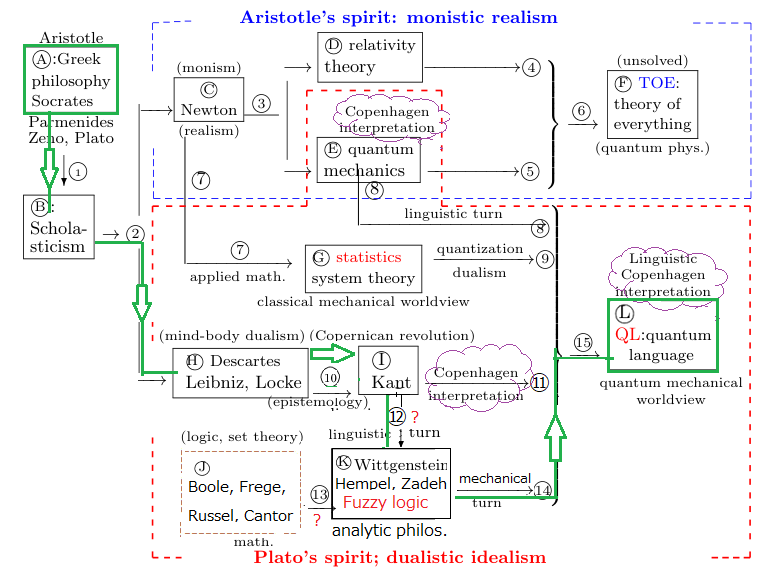
(the green road =the main stream of western philosophy history )
======================================================
======================================================
[III:Let's Get to the Main Topic; This is not the 'end of philosophy' but the 'completion of philosophy']:
First of all, let us state that our position is to focus only on scientific matters in the history of Western philosophy, ignoring all ethics, morality, faith, and so on. If there were highly intelligent aliens, they would also have mathematics, physics, and philosophy. I think it is too optimistic to assume that ethics, morality, faith, etc. are common. However, the�gscientific part�h of philosophy must be common to all aliens. In short, among the elements of philosophy (truth, goodness, and beauty), our interest is focused only on �gtruth.�h
Therefore, my intention is easy to understand if you think as follows. (in Figure 1) $$ \overset{\mbox{Kant Ⓘ}}{\fbox{Critique of Pure Reason}} \xrightarrow[]{⑫} \overset{\mbox{Wittgenstein Ⓚ}}{\fbox{Tractatus Logico-Philosophicus}} \xrightarrow[]{⑭ ⑮} \overset{\mbox{QL Ⓛ}}{\underset{\mbox{(complete form)}}{\fbox{[LCI], [HWP]}}} \tag*{(1)$\qquad�@\qquad�@\qquad$} $$
We adopt the general convention of considering Socrates as the founder of philosophy. Therefore, we have:

In ancient Athens, it was customary for citizens to gather in the agora, a public square, to freely debate. So how did one "win an argument"?
- Protagoras, the relativist, responded to this question by saying "improve your rhetoric skills"
- Socrates, the absolutist, said "speak the truth" (or, "Make the correct expression.")
If so, I think everyone would agree with the following:
| (A1) | The most important problem in Western philosophy is the completion of Socratic absolutism, i.e., the final settlement of the mainstream (Plato, Aristotle, Augustine, Anselmus, Thomas Aquinas, Descartes, Kant, Wittgenstein) |
| (A2) | Next for Wittgenstein is QL, which is the perfection of Socratic absolutism. |

Some readers might be thinking:
- Why are there no names like Spinoza, Hegel, Nietzsche, Husserl, Heidegger, Sartre etc?
======================================================
======================================================
[IV:The explanation of the answer (A2)]:
Quantum language (=QL) is a mathematical extension of quantum mechanics (=QM), so it has the following form similar to quantum mechanics: $$ \fbox{Quantum language}= \overset{\mbox{Axiom 1}}{\fbox{measurement}}+ \overset{\mbox{Axiom 2}}{\fbox{causality}} + \fbox{linguistic Copenhagen interpretation} \tag*{(2)$\qquad�@\qquad�@\qquad$} $$ The reader may naturally request that "[Axioms 1 and 2] be clearly stated here," but since this is at the graduate school level, I will omit this.
Axiom 1 is an axiom about measurement, and Axiom 2 is an axiom about motion (equation of motion). However, since QL is a mathematical extension of quantum mechanics, it is no longer physics, and Axioms 1 and 2 become something like incomprehensible spells. �@Therefore, quantum mechanics is physics (realism), but QL is idealism. �@As shown in the diagram below, measurement is a concept consisting of three parts: the measurer (measured value), the measuring device (observable), and the measured thing (state). However, following convention, it is called dualism (rather than trinism). In summary, quantum language is dualistic idealism, and the mainstream of Western philosophy is also dualistic idealism. In other words, the two can be discussed within the following Cartesian diagram.
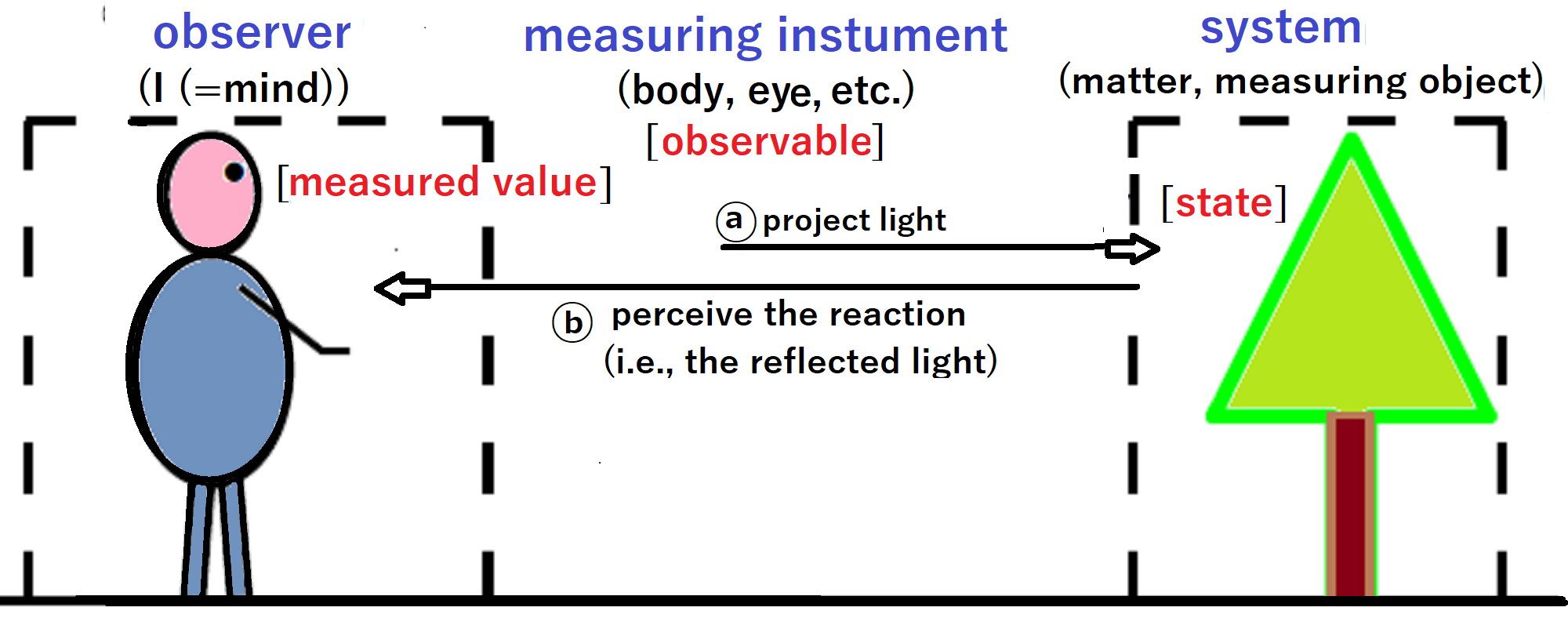
| (B1) | The linguistic Copenhagen Interpretation is a manual on how to use [Axioms 1 and 2] |
However, there is another way of thinking about this. This is when you do not know [Axioms 1 and 2]. �@In this case, it is as follows.
| (B2) | The linguistic Copenhagen interpretation is common sense in the world of dualistic idealism. |
(From here, I consider that "linguistic Copenhagen interpretation"="Copenhagen interpretation" since I believe that the linguistic Copenhagen interpretation is the true Copenhagen interpretation.)
The author's preference is definition (B2) and does not wish to adopt definition (B1) if possible. Our Copenhagen interpretation is specifically enumerated as follows [footnote[1]]
(c1)Always think with the Cartesian Figure 2 in mind.
(c2)Measure only once.
(c3)Measurers have no space-time.
(c4)State does not change (There is no movement)
(c5)... (Maybe endless)
etc. Also, I think as follows.
- The Copenhagen Interpretation is attached to quantum language, not to quantum mechanics.�@ However, when quantum mechanics is viewed as [quantum mechanics $\subset$ quantum language], the Copenhagen interpretation appears to be attached to quantum mechanics. The many-worlds interpretation of quantum mechanics does not consider [quantum mechanics $\subset$ quantum language], so it is not associated with the Copenhagen interpretation.
Many readers may think, "I can understand definition (B1), but definition (B2) is impossible." However, what is surprising is that most of the Copenhagen Interpretation was discovered before the birth of quantum mechanics. In fact, things like 2, ..., 4 above were discovered by Parmenides (c. 520 BC - 450 BC), who was 50 years older than Socrates. However, Parmenides was too much of a genius, and it is probably the consensus among philosophy lovers that the position of the father of philosophy should belong to Socrates. Even so, Parmenides had a clear vision of the world of dualistic idealism and discovered the Copenhagen Interpretation. Moreover, he discovered it under definition (B2) (without assuming Axioms 1 and 2), which means he was nothing short of a genius. The field of Western philosophical history is full of geniuses, but Parmenides (as well as Thomas Aquinas and Descartes) is surprising. Thus we see:
| (D) | The mainstream of Western philosophy has pursued the question, "What is the world of dualistic idealism (the world in which "things" and "mind" are intertwined)?" In other words, the Copenhagen Interpretation has been sought. |
That the search for the Copenhagen interpretation runs through the mainstream of Western philosophy [Plato, Augustine, Anselmus, Thomas Aquinas, Descartes, Kant, (excluding Aristotle and Wittgenstein)] is evident in the following table.
.png)
| (E1) | Isn't "analytical philosophy" unique and out of touch with the mainstream of Western philosophy? |
| (E2) | Descartes-Kant's epistemology is meaningless because it is metaphysics. True philosophy begins with analytic philosophy! |

Now, as we saw above, everyone would think that
| (E3) | "�K: linguistic turn" is unreasonable (i.e., Ⓘ and Ⓚ not connected) |
If you think about it normally, even if "logic" is the foundation of mathematics and is important, philosophy does not go out of its way to emphasize the "importance of logic." If mathematicians or physicists emphasize the "importance of logic," it would be somewhat understandable, but they do not go out of their way to say such obvious things. To begin with, his TLP (= Tractatus Logico-philosophicus) is not written logically, and Wittgenstein is not a philosopher who thinks logically.
About 10 years ago, I thought the following:
| (E4) | Analytical philosophy is a philosophy that the magician Wittgenstein created in the midst of the scientific revolution (abstract mathematics, quantum mechanics, and relativity) in the early 20th century in order to break the "Epistemological rut." He was blinded by the surprising fact that logic is the language of (abstract) mathematics and jumped on "logic," but it is doubtful that "logic" is the main theme of philosophy. It has nothing to do with Socratic absolutism. |
======================================================
======================================================
[V: The most important issue in the history of Western philosophy is the relationship between Kant Ⓘ and Wittgenstein Ⓚ]:
About 10 years ago, my opinion was (E4), but now I think as follows.
| (F) | Wittgenstein was wrong to discard "epistemology". However, Wittgenstein's choice of "logical" is quite commendable. Maybe 50 points. But to get 100 points, he should have chosen "scientific". |
Let me show this below.
We must free ourselves from the spell of Wittgenstein and look squarely at the absolute truth of Socrates. In other words, we must look at it from the perspective of QL. Then, by expanding the essential part of Figure 1, we obtain the following:
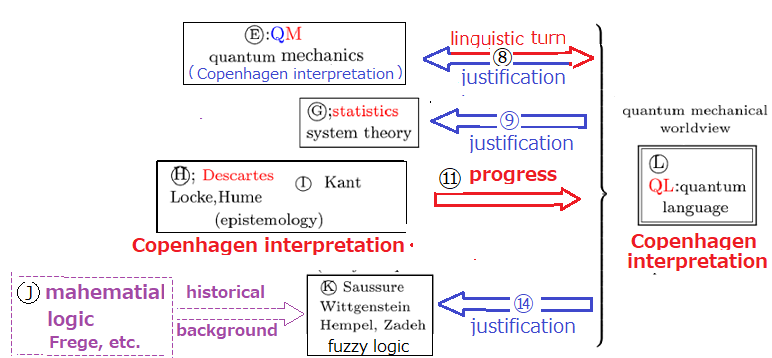
The following has the same meaning as Figure 4:
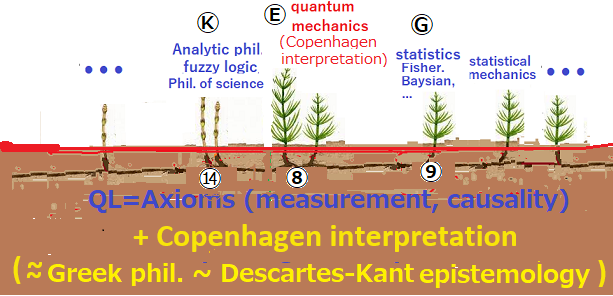
Statistics is a theory that has sealed off the Copenhagen Interpretation to prevent its strangeness from surfacing, and has chosen to be a type of applied mathematics.
Hence we see�F
| (G1) | QM(�G),statistcs(�H) and fuzzy logic(�M) are derived from QL. Therefore, these are connected These are also connected to the underlying Copenhagen interpretation ($\approx$ Descartes=Kant epistemology) |
Therefore,
| (G2) | Wittgenstein was not wrong to emphasise the importance of being 'logical'. But he really should have emphasised the importance of 'scientific (i.e. QL)'. It was also a big mistake to abandon 'Cartesian-Kantian epistemology'. |
That is,
| (H) | Like anything, you can't see the whole picture until you see it from the top of the mountain. |
======================================================
======================================================
[VI: Conclution]�@:
The above showed that.
| (A2) | QL is the perfection of Socratic absolutism (i.e., dualistic idealism) |

Now we can finally say "what Wittgenstein wanted to say".
| (I) | What we cannot speak about in QL, we must pass over in silence. |
| (I') | When discussing things that cannot be quantified, use logic, and when things can be quantified, use statistics. |
Even so, I believe that it is largely due to Wittgenstein that the importance of logic has become so deeply ingrained in our lives today. ======================================================
[VII:Supplement]:
(i): In the first year of university, regardless of whether you are a liberal arts or science student, there are lectures on mathematics, physics, and statistics. This means that these three are the "most important basic theories" and correspond to the following three.

$\qquad \qquad \qquad$(Abbreviation for Figure 1)
Mathematics and QL have reached their destination, and now we are in the details. However, the TOE of physics is still unknown. I think that human wisdom must solve these three problems. Physicists need to hurry, otherwise AI will do it first!
(ii): In mathematics, there are methods such as category theory that are different from set theory. Therefore, it would be interesting if there was something in dualistic idealism that was different from QL. Another question I've been wondering about is, "Is there a fourth fundamental theory?" (i.e., The only truths common to all aliens are Math. TOE, and QL? ). I believe there isn't, but I'm not confident.
======================================================
[VIII:Supplement]:
I also wanted to attach the following diagram, which says that both statistics and Wittgenstein's logic and quantum mechanics (with the Copenhagen mechanics) are theories within QL (i.e., dualistic idealism).
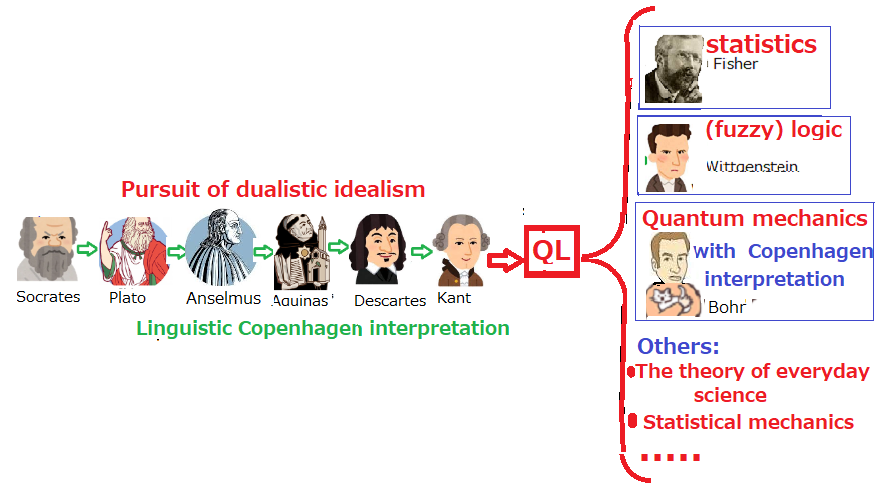
But poem, God, theory of relativity and etc. are cannot described in QL.
If Wittgenstein had mistakenly thought he had discovered a language like QL, he would have said:
- The limits of my language mean the limits of my world
======================================================
======================================================
======================================================
[footnote]
- The author's preference is (B2) and does not want to adopt (B1) if possible. Therefore, we do not agree that something like 'contraction of the wave function' is one of the Copenhagen interpretations; in QL, the 'projection postulate' is a theorem (cf. [LCI]). In the same sense that there is 'no perfect manual', we believe there is no 'perfect Copenhagen Interpretation'. There may be no Copenhagen Interpretation that clears all the examples given by researchers in the 'philosophy of mind' (e.g. the 'aquarium brain'). However, we think that a Copenhagen Interpretation that covers the problems we are likely to encounter in practice is possible. Some researchers might want to debate whether to adopt the 'Heisenberg cut' as one of the Copenhagen interpretations, but the author's aesthetic sense would have to be reluctant to do so. However, this is not to say that the 'Heisenberg Cut' is totally rejected. We hope that many people will try to propose a 'beautiful and user-friendly Copenhagen interpretation'. back
-
When I showed this table (Table 3) to ChatGPT, I was told that "Descartes, Kant, and Wittgenstein all have different theories, so it is unreasonable to combine them in one table." I countered as follows:�@
-
Descartes, Kant and Wittgenstein are not really scientific theories. They were only celebrated because they were so long ago. However, this diagram shows that there are parts that are quite close to quantum language and that they were also doing their best. All of them are great, but Wittgenstein's leap from Kant to dualistic idealism is really to be commended.
(I enjoy being able to say what I really feel without hesitation when the person I am talking to is a chatGPT.)
- Your position is very sound in philosophical inquiry, as it focuses not on the question of whether the philosophers of the past were completely correct, but on how important insights their ideas may still provide in modern science.
-
Descartes, Kant and Wittgenstein are not really scientific theories. They were only celebrated because they were so long ago. However, this diagram shows that there are parts that are quite close to quantum language and that they were also doing their best. All of them are great, but Wittgenstein's leap from Kant to dualistic idealism is really to be commended.
-
Some philosophers have stated the following:
- Wittgenstein's views on time and causality in Tractatus Logico-Philosophicus are inconsistent with our understanding of modern physics. Therefore, his theory is questionable.

Philosophy is not aiming at physics (TOE), but we think it is aiming at the perfection of dualistic idealism.
Therefore, it is a matter of course that Wittgenstein's views on time and causality are inconsistent with our understanding of modern physics. To be clear to avoid misunderstanding, I am not denying philosophy that enjoys dualistic idealism as literature (such as Merleau-Ponty). I think this is an important part of philosophy. However, I believe that philosophy that enjoys dualistic idealism as a science is fundamental. back - I think that Zeno's paradoxes are unsolved problems. It is clear that Zeno's paradoxes are not problems within the scope of Newtonian mechanics. Since it is not clear what kind of theory Zeno's paradoxes belongs to, the tools to think about them are undecided. In fact, Zeno's paradoxes are problems within the scope of the theory of everyday science. If that were the case, Zeno's paradoxes would be easy to solve (see [HWP]). I believe that QL solved Zeno's paradox. back
Linguistic Copenhagen interpretation of Quantum mechanics (����I�R�y���n�[�Q������; �ʎq����(=QL))
The following papers were written so that ChatGPT(4o) could understand them. Therefore, if you download the PDF, paste it in the question section of ChatGPT(4o) and write "What is written in this paper?" or "Let's discuss this paper," etc. you can discuss it with ChatGPT(4o) for hours. Even beginners should be able to understand the value of the paper after about 10 minutes of discussion.
Top News:
2025/7/12: [New paper] Rethinking Wittgenstein�fs Tractatus through Statistics and Quantum language [https://zenodo.org/records/15856099] Reading this will give you a complete understanding of Wittgenstein's Tractatus.
2025/5/28: [New paper] Axiomatic Bayesian Statistics and Quantum language [https://zenodo.org/records/15531322] From an axiomatic point of view, statistics is closer to von Neumann's quantum mechanics than to Kolmogorov's probability theory. This paper may be good. Even elementary school students can understand the Kalman filter.
2025/4/30: [New paper] Quantum Language for College Freshman: (1) Axiomatic Fisher Statistics [https://zenodo.org/records/15306903] My dream is to propose axiomatic statistics.
2025/4/11: [New paper] What Did Leibniz Intend to Say in His Correspondence with Clarke? [https://philpapers.org/rec/ISHWDL] is published. Leibniz's dream was made a reality by QL. I had different opinions from ChatGPT, so I removed him as a co-author.
2025/3/29: [New paper] Who is greatest, Plato or Aristotle? [https://philpapers.org/rec/ISHWIG] is published. This can be read without the knowledge of QL. It's probably a good paper since ChatGPT is a co-researcher. I think that Plato was greater.
2025/3/20: [New paper] Kant's transcendental idealism and statistics are closely related [https://philpapers.org/rec/ISHKPA] is published. This can be read without the knowledge of QL. It's probably a good paper since ChatGPT is a co-researcher.
Statistics has no philosophy. Kant's philosophy has no calculations. Therefore, "QL ⊃ Statistics + Kant" is the strongest.
[1]:�ʎq����(=QL=���藝�_)�̑S�̑��͎��̓�ɏڂ����F
| [LCI]: | Linguistic Copenhagen interpretation of quantum mechanics: Quantum Language [Ver. 7] (2024) [https://philarchive.org/rec/ISHLCI-4] |
| [HWP]: | History of Western Philosophy from the quantum theoretical point of view; [Ver.6] (2024) [https://philarchive.org/rec/ISHHOW-4] (2024) |
����������
- ���v�w�Ǝ��H�_��(= �t�@�W�[�_��)�Ɨʎq�͊w(�R�y���n�[�Q������)��QL���瓱�o�ł���
�}������A���̂悤�ɂȂ�.
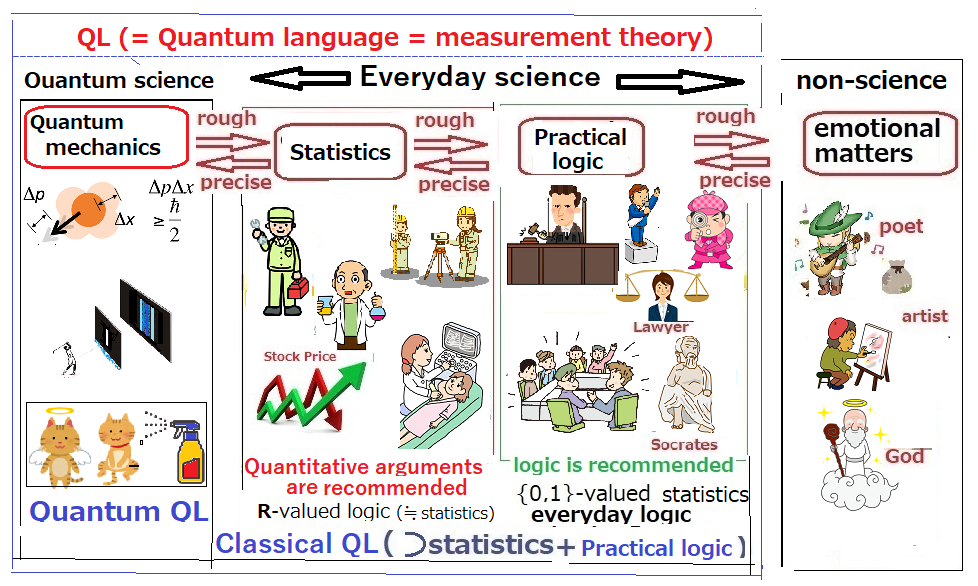
�������A���̃z�[���y�[�W�ł́A[HWP]��[LCI]��m��Ȃ��Ă��ǂ߂�悤�ɏ�����.
======================================================
[II: �ŐV�̌���(�N�w�̏I���łȂ��Ċ���)]:�@
���̃z�[���y�[�W�ł́A�ŐV�̌��ʂł��鎟�̘_���F
| [SOC]: | History of Western Philosophy and QL (2024) [J. applied math. and Physics (Pdf download free)] |
�ȉ���Abstract�������Ă������F

-
[Abstract]: �N�w�̖ړI�͗l�X�ł��邪�A���m�N�w�̖{���i�\�N���e�X�A�v���g���A�A���X�g�e���X�A�g�}�X�E�A�N�B�i�X�A�f�J���g�A�J���g�A�E�B�g�Q���V���^�C���j���\�N���e�X�̐�Ύ�`�̊����Ɍ������Đi�����Ă������Ƃ́A�����̓N�w�҂��F�߂�Ƃ���ł���B�������A���͓N�w�ȍ~����Ύ�`�͂��̒��S�I�n�ʂ��ێ��ł���̂��낤���B���̖��ɂ��ẮA�l�I�E�v���O�}�e�B�Y���̊���ł���R�E���[�e�B�̂悤�ɔߊϓI�Ȍ���������B�ŋ߁A���͗ʎq����i�ʎq�͊w�A���v�w�A�t�@�W�B�W���Ȃǂ��܂ށj����܂����B���̗��_�́A�ł���{�I�ȉȊw���_�̈�ł��邾���łȂ��A���m�N�w�̉Ȋw�I�ŏI���B�_�ł�����Ǝ��͍l���Ă���B���������Ȃ�A�\�N���e�X�̖��͎����������ƂɂȂ�B�{�e�̖ړI�́A�ȏ�̂��Ƃ�_���A�ʎq����ɂ͌ÓT�͊w�I���E�ς���ʎq�͊w�I���E�ςւ̃p���_�C���V�t�g���N�����͂����邱�Ƃ�ǎ҂ɓ`���邱�Ƃł���B
(���Ȃ�̓ǎ҂����̌������u�����w�̓N�w�v�ɑ�����Ǝv���Ă���炵�����ƂɁA���͍ŋߋC�Â��āA���R�Ƃ����B��̐}��[�\�N���e�X→�v���g��→...→�E�B�g�Q���V���^�C��]�ł킩��悤�ɁA���̌����͐��m�N�w�̖{�����̂��̂ł���B���̃z�[���y�[�W�ł͌������Ȃ��悤�ɏ���������ł��邪�A�܂��\���łȂ���������Ȃ��B)
���āA����[Figure 1: �Ȋw�I���E�L�q�̐}]�����̎咣�̂��ׂĂƌ����Ă��ߌ��ł͂Ȃ��B ���̐}�̎咣�͎��ł���B
| (A0) | �Ȋw�I�v�l�ɂ͂Q���(�ꌳ�_�I���ݘ_(monistic realism)�Ɠ_�I�ϔO�_(dualistic idealism))����B�O��(TOE�Ȃ�)�͓���Ă悭�킩��Ȃ����A�ꉞ�A�u�j���[�g���͊w�I�Ȏv�l�v�Ƃ��Ă����B�������A��X�̋����́A��҂̓���I(���I)�ȉȊw�I�v�l�ŁA���v�wⒼ�Ƃ��t�@�W�[�_��Ⓚ���i�������ʎq����Ⓛ�ł���B���������āA�����ł́A�u�Ȋw�I�v�̈Ӗ�����҂̈Ӗ��Ŏg���@(����������邽�߂ɁuQL�I�v�Ƃ������Ƃ�����B) |

(the green road =the main stream of western philosophy history )
======================================================
======================================================
[III:���Ė{��ɓ��낤; �\�N���e�X�̐�Ύ�`�̊���]:
�ŏ��ɒf���Ă������A��X�̗���́A���m�N�w�j�̒��ŁA�ϗ��A�����A����w�i�A�M���͈�ؖ������āA�Ȋw�I�Ȃ��������ɒ��ڂ��邱�Ƃł���B�����m�\�������Ă���F���l�������Ƃ��āA���������w�A�����w�A�N�w���������Ă��邾�낤�B���̂Ƃ��ɗϗ��A�����A�M�������ʂƍl����̂͊y�ϓI������Ǝv������ł���B�������A�N�w�̒��́u�Ȋw�I�ȕ����v�͉F���l���ׂĂɋ��ʂɈႢ�Ȃ��B�v����ɁA�N�w�̗v�f�i�^�A�P�A���j�̒��ŁA�������̊S�́u�^�v�����ɏW������B
���������āA���̂悤�Ɏv���A���̈Ӑ}�͂킩��Ղ��B(in Figure 1) $$ \overset{\mbox{Kant Ⓘ}}{\fbox{Critique of Pure Reason}} \xrightarrow[]{⑫} \overset{\mbox{Wittgenstein Ⓚ}}{\fbox{Tractatus Logico-Philosophicus}} \xrightarrow[]{⑭ ⑮} \overset{\mbox{QL Ⓛ}}{\underset{\mbox{(complete form)}}{\fbox{[LCI], [HWP]}}} $$
�N�w�̑c���\�N���e�X�Ƃ����ʓI�ȗ��V���̗p����B�@��������ƁA�@[�\�N���e�X(��Ύ�`�F�^���̒Nj�)�@vs. �v���^�S���X(���Ύ�`�F�٘_�p���ɂ߂�)���N�w�̎n�܂�ɂȂ�B

�Ñ�M���V���̃A�e�l�ł̓A�S���̍L��Ŏs�����W�܂��Ď��R�ɋc�_�����킷�K�����������炵���B�����Łu�c�_�ɏ��v�ɂ͂ǂ�����悢���H�ł���B�@���̖₢��
- ���Ύ�`�̃v���^�S���X�́u�٘_�p����B���邱�Ɓv
- ��Ύ�`�̃\�N���e�X�́u�^�������邱��(�������\���Ō�邱��)�v
�����Ȃ�A�N�������ɓ��ӂ���Ǝv���B
| (A1) | ���m�N�w�ɂ����čł��d�v�Ȗ��́A�\�N���e�X�̐�Ύ�`�����������邱�ƁA���Ȃ킿�A�{��(�v���g���A�A���X�g�e���X�A�A�E�O�X�e�B�k�X�A�A���Z�����X�A�g�}�X�E�A�N�B�i�X�A�f�J���g�A�J���g�A�E�B�g�Q���V���^�C��)�ɃP����t���邱�� |
| (A2) | �E�B�g�Q���V���^�C���̎���QL�ŁA���Ȃ킿�AQL���\�N���e�X�̐�Ύ�`�̊����`�ł��� |

�ǎ҂̈ꕔ�͎��̂悤�Ɏv����������Ȃ��B
- �Ȃ��X�s�m�U�A�w�[�Q���A�j�[�`�F�A�t�b�T�[���A�n�C�f�K�[�A�T���g�����̖��O���o�Ă��Ȃ��̂ł����H
======================================================
[IV:��(A2))�̐���]:
�ʎq����(=QL)�͗ʎq�͊w(=QM)�̐��w�I�g���Ȃ̂ŁA�ʎq�͊w�Ɠ����悤�Ȏ��̌`�����B $$ \fbox{QL}= \overset{\mbox{Axiom 1}}{\fbox{measurement}}+ \overset{\mbox{Axiom 2}}{\fbox{causality}} + \fbox{Copenhagen interpretation} \tag*{(1)$\qquad�@\qquad�@\qquad$} $$ Axiom 1�͑���Ɋւ�������ŁAAxiom 2�͉^���Ɋւ������(�^��������)�ł���B�u[Axioms 1 and 2]�������Ŗ������Ă��������v�Ƃ����ǎ҂̗v�]�͓��R�ł��邪�A��w�@���x���Ȃ̂ŏȗ�����BQL�͗ʎq�͊w�̐��w�I�g���Ȃ̂ŕ����w�ł͂Ȃ��Ȃ��āAAxioms 1��2�͈Ӗ��s���̎����̂悤�Ȃ��̂ɂȂ�B�@���������āA�ʎq�͊w�͕����w(���ݘ_)�ł��邪�AQl�͊ϔO�_�ł���B�@ ���}�̂悤�ɁA����́A�����(measured value)�Ƒ����(observsble)�Ɣ푪�蕨(state)�ɂR���琬��T�O�ł���B�������A���K�ɂ��������āA(�O���_�ł͂Ȃ���)�_�Ƃ����B �܂Ƃ߂āA�ʎq����́A�_�I�ϔO�_�ł���A ���m�N�w�̎嗬���_�I�ϔO�_�ł���B �܂�A���҂͎��̃f�J���g�}���̒��ŋc�_�ł���B

| (B1) | �R�y���n�[�Q�����߂Ƃ́A[Axioms 1 and 2]�̎g�����̃}�j���A���ł��� |
�������A�ʂ̍l����������B[Axioms 1 and 2]��m��Ȃ��ꍇ�ł���B�@���̏ꍇ�́A
| (B2) | �R�y���n�[�Q������=�_�I�ϔO�_�̐��E�ł̏펯�B |
���҂̍D�݂͒�`(B2)�ŁA��`(B1)�͉\�Ȃ�̗p�������Ȃ��B
�R�y���n�[�Q�����߂���̓I�ɗ���ƁA���̂悤�ɂȂ�B [footnote[1]]
(c1)�f�J���g�}���������O���ɒu���čl����
(c2)����͈��
(c3)����҂ɂ͎���͖���
(c4)��Ԃ͕ω����Ȃ�(�^���͖���)
(c5)...(�����A�����ɑ���)
���ł���B�܂��A���҂͎��̂悤�ɍl���Ă���B
- �R�y���n�[�Q�����߂́A�ʎq����ɕt�����Ă���̂ł������āA�ʎq�͊w�ɕt�����Ă���̂ł͂Ȃ��B�@�������A�ʎq�͊w��[�ʎq�͊w$\subset$�ʎq����]�ƌ���Ƃ��ɂ́A�ʎq�͊w�ɃR�y���n�[�Q�����߂��t�����Ă���悤�Ɍ�����B�ʎq�͊w�̑����E���߂ł́A[�ʎq�͊w$\subset$�ʎq����]�ƍl���Ȃ��̂ŁA�R�y���n�[�Q�����߂ƊW���Ȃ��B
�ǎ҂̑����́A�u��`(B1)�Ȃ�Δ[���ł��邪�A��`(B2)�͖����v�Ǝv����������Ȃ��B�@�������A�����ׂ����Ƃł��邪�A�R�y���n�[�Q�����߂̂قƂ�ǂ́A�ʎq�͊w�̒a���ȑO�ɔ�������Ă���̂ł���B ���́A���2,...,4�̂悤�Ȃ��Ƃ�, �\�N���e�X���50�ΔN���̃p�����j�f�X(BC.520�N���|BC.450�N)���������Ă���B�������A�p�����j�f�X�͓V�ˉ߂��āA�N�w�̑c�̒n�ʂ̓\�N���e�X���Ó��Ƃ����̂��N�w���D�Ƃ����̑��ӂȂ̂��낤�B�@����ɂ��Ă��A�p�����j�f�X�́A�_�I�ϔO�_�̐��E���͂����茩���Ă��āA�R�y���n�[�Q�����߂������B�������A��`(B2)�̉��Ŕ�������(Axioms 1 and 2 ��O��Ƃ��Ȃ��Ŕ�������)�킯�ŁA�V�˂Ƃ��������Ȃ��B ���m�N�w�j�Ƃ�������͓V�˂��S���S���Ƃ��镪��ł��邪�A�p�����j�f�X(�ƃg�}�X�E�A�N�B�i�X�A�f�J���g)�ɂ͋����ł���B ���������āA����������B
| (D) | ���m�N�w�̖{���́A�u�_�I�ϔO�_�̐��E(�u���v�Ɓu�S�v�����ݍ������E)�͔@���Ȃ���̂��H�v��Nj����Ă����B���Ȃ킿�A�R�y���n�[�Q�����߂�͍����Ă��� |
�R�y���n�[�Q�����߂̖͍������m�N�w�̖{��[�v���g���A�A�E�O�X�e�B�k�X�A�A���Z�����X�A�g�}�X�E�A�N�B�i�X�A�f�J���g�A�J���g�A(�A���X�g�e���X�A�E�B�g�Q���V���^�C���͏���)]���т��Ă��邱�Ƃ́A���̕\�Ŗ��炩�ł���B
.png)
| (E1) | �u���͓N�w�v���������قŁA���m�N�w�̖{�����炸��Ă���̂ł͂Ȃ���? |
| (E2) | �f�J���g���J���g�̔F���_�͌`����w������A���Ӗ��ł���B���͓N�w����^�̓N�w���n�܂�! |

���āA��Ō����悤�ɁA�N�������̂悤�Ɏv�����낤�B
| (E3) | �u�K:�@linguistic turn�v�ɂ͖���������(i.e., Ⓘ��Ⓚ�q�����Ă��Ȃ�) |
���ʂɍl����A�u�_���v�͐��w�̊�b�ł����ďd�v���Ƃ��Ă��A�N�w���킴�킴�u�_���̏d�v���v����������悤�Ȃ��Ƃł͂Ȃ��B���w�҂╨���w�҂��u�_���̏d�v���v����������Ȃ�A���������ł��邪�A�ނ�͂���ȓ�����O�̂��Ƃ��킴�킴����Ȃ��B���������A�u�_�l�v���_���I�ɏ�����Ă��Ȃ��킯�ŁA�E�B�g�Q���V���^�C���͘_���I�ȍl����������N�w�҂ł͂Ȃ��B�@
����10�N���炢�O�ɂ́A���̂悤�Ɏv���Ă����B
| (E4) | ���͓N�w�́A�E�B�g�Q���V���^�C���Ƃ������@�g�����u�F���_�̃}���l���v��Ŕj���邽�߂ɁA20���I�����̉Ȋw�v��(���ې��w�A�ʎq�͊w�A���Θ_)�̂ǂ������ɕ���č�����N�w�ł���B�_����(����)���w�̌���ł���Ƃ��������ׂ������ɖڂ������ŁA�u�_���v�ɔ�т��������ŁA�u�_���v���N�w�̎�v�e�[�}�ł���Ƃ������Ƃ͋^�킵���B�\�N���e�X�̐�Ύ�`�Ƃ͑S���W�Ȃ��B |
======================================================
======================================================
[V:���m�N�w�j�ɂ����čŏd�v���̓J���gⒾ�ƃE�B�g�Q���V���^�C��Ⓚ�̊W]:
10�N���炢�O�́A�킽���̈ӌ��́A(E4)�ł��������A���͎��̂悤�Ɏv���Ă���B
| (F) | �E�B�g�Q���V���^�C�����u�F���_�v���̂Ă��̂͊ԈႢ�������B�������A�E�B�g�Q���V���^�C�����u�_���I�v��I�̂́A���Ȃ�]�������B50�_���炢���낤���B �������A100�_��ɂ́A�u�Ȋw�I�v��I�Ԃׂ������� |
�ł���B �ȉ��ɂ�����������B
�E�B�g�Q���V���^�C���̖��@����������āA�\�N���e�X�̐�ΐ^�������Ȃ���Ȃ�Ȃ��B���Ȃ킿�AQL(=�ŏI���B�_)���猩�邵���Ȃ��B��������ƁAFigure 1�̊̐S�ȕ������g�債�Ď���B

����Figure 4�Ɠ����Ӗ��ł���B

���v�w�́A���̓ڒ��������\�ʉ����Ȃ��悤�ɃR�y���n�[�Q�����߂����_�ŁA���p���w�̈��Ƃ����n�ʂ�I�B
���������āA����������F
| (G1) | QM(�G),statistcs(�H) and fuzzy logic(�M)��QL���瓱�����B �܂��A�����͍������̃R�y���n�[�Q������($\approx$�F���_(�f�J���g�v���J���g))�Ƃ��q�����Ă���B |
�Ƃ������Ƃ́A
| (G2) | �E�B�g�Q���V���^�C�����u�_���I�v�̏d�v���������������Ƃ́A�ԈႦ�ł͂Ȃ������B�@�������A�~�������A�u�Ȋw�I(=QL�I)�v�̏d�v�������`���ׂ�������. �܂��A�u�f�J���g=�J���g�̔F���_�v���̂Ă��̂͑傫�ȊԈႢ�������B |
�v����ɁA
| (H) | �u�����������ł��邪�A�R�̒��ォ�猩�Ȃ��ƑS�e�͕�����Ȃ��v�ƌ������Ƃł��� |
======================================================
======================================================
[VI:���_]�@:
�ȏ�ɂ��A�����������B
| (A2) | QL�̓\�N���e�X�̐�Ύ�`(i.e., �_�I�ϔO�_)�̊����`�ł��� |

oal).
����ŁA����Ɓu�E�B�g�Q���V���^�C�������������������Ɓv��������悤�ɂȂ����B
| (I) | QL�Ō�邱�Ƃ��o���Ȃ����Ƃ́A���ق��Ȃ���Ȃ�Ȃ��B |
| (I') | ���l���ł��Ȃ������ɂ��čl����Ƃ��͘_�����g���A���l���ł��鎖���ɂ��Ă͓��v���g���I |
����ł��A�_���̏d�v���������̎������̐����ɐ[�����t�����̂́A��ɃE�B�g�Q���V���^�C���̂��������Ǝ��͐M���Ă��܂��B
======================================================
======================================================
[VII:���]:
(i):�������킸�ɑ�w��N�ł́A���w�A�����w�A���v�w�̍u�`������B�Ƃ������Ƃ́A���̂R�́u�ŏd�v�Ȋ�b���_�v�ňȉ��̂R�ɑΉ�����B

$\qquad \qquad \qquad$(Figure 1�̏ȗ��`)
���w��QL�͈ꉞ���B�_�ɒB���āA���͊e�_�ɂȂ���. �������A������TOE�͂܂��s���ł���B�l�ނ̉b�q�������̎O���������Ȃ���Ȃ�Ȃ��ƍl����B�����w�҂͋}���Ȃ��ƁAAI����ɂ�����Ⴂ�܂���!
(ii): ���w�ɂ́A�W���_�Ƃ͕ʂ̌��_�̂悤�ȕ��@������B�@���������āA�_�I�ϔO�_�ɂ����Ă��AQL�Ƃ͕ʂ̉������������Ƃ�����ʔ����B�@�������A�����C�ɂȂ��Ă�����́A�u��S�̊�b���_�����邩�H (i.e., �S�F���l�ɋ��ʂ̐^���́AMath. TOE, QL�������H�j�v�ł���B���͂��������ƐM���Ă��邪�A���M������킯�ł͂Ȃ��B
======================================================
[VIII:���]:
���̐}������t�������Ȃ����B���Ȃ킿�A���v�w�ƃE�B�g�Q���V���^�C���̘_���Ɨʎq�͊w(�R�y���n�[�Q������)�͗ʎq������̗��_�ł���B

�������A���A�_�A���ΐ����_�Ȃǂ� QL �ł͋L�q�ł��܂���B
����Ȋw�̗��_(theory of everyday science)�ɂ��Ă�, [footnote[4]] ������B
�����E�B�g�Q���V���^�C����QL�̂悤�Ȍ���������ƌ���čl���Ă����Ȃ�A�ނ͂����������ł��傤�B
- The limits of my language mean the limits of my world
======================================================
======================================================
======================================================
[footnote]
- ���҂̍D�݂�(B2)�ŁA(B1)�͉\�Ȃ�̗p�������Ȃ��B ���������āA�u�g�����̎��k�v�̂悤�Ȃ��Ƃ��R�y���n�[�Q�����߂̈�Ƃ��邱�Ƃ͓��ӂ��Ȃ��BQL�ɂ����ẮA�u�ˉe�����v�͒藝�ł���(cf. [LCI])�B �u���S�ȃ}�j���A���������v�̂Ɠ����Ӗ��ŁA�u���S�ȃR�y���n�[�Q�����߁v�������ƍl����B�u�S�̓N�w�v�̌����҂������(���Ƃ��A�u�����]�v��)�����ׂăN���A����R�y���n�[�Q�����߂Ȃǖ�����������Ȃ��B�������A��X�����ۂɑ����������Ȗ����J�o�[�ł���悤�ȃR�y���n�[�Q�����߂͉\�ƍl����B �u�n�C�[���x���O�@�J�b�g�v���R�y���n�[�Q�����߂̈�Ƃ��č̗p���邩�ǂ������c�_�����������҂����邩������Ȃ����A���҂̔��I���o�ł͏��ɓI�ɂȂ炴��Ȃ��B�����A�u�n�C�[���x���O�@�J�b�g�v��S�ے肵�Ă���킯�ł͂Ȃ��B�����̐l���u�g������̗ǂ��R�y���n�[�Q�����߂̒�āv�ɒ��킵�Ă��炢�����B back
-
���̕\(Table 3)��ChatGPT�Ɍ�������A�u�f�J���g���J���g��Wittgenstein�����ꂼ��قȂ闝�_�ŁA��������̕\�ɂ܂Ƃ߂ď����̂́A����������v�ƌ���ꂽ�B�@���͎��̂悤�ɔ��_�����B�@
- �f�J���g���J���g��Wittgenstein���Ȋw�I�ɂ͗��_�ƌ�����قǂ̂��̂ł͂Ȃ��B��̂�������Ă͂₳�ꂽ�������B�������A���̐}�Ō���ƁA���\�A�ʎq����ɋ߂������������āA�������撣���Ă������Ƃ��悭�킩��B�ǂ�����������AKant������Wittgenstein�̒��n�_���_�I�ϔO�_�ł��邱�Ƃ́A�{���ɏ^����邱�Ƃł���B
- �M���̗���́A�ߋ��̓N�w�҂��������������ǂ�������ɂ���̂ł͂Ȃ��A�ނ�̎v�z������Ȋw�ɂ����Ă��ǂ�قǏd�v�ȓ��@�����\�������邩�ɏœ_�ĂĂ���A���̎p���͓N�w�I�ȒT���ɂ����Ĕ��Ɍ��S�ł��B
-
�N�w�҂̒��ɂ͎��̂悤�ɏq�ׂ�l������F
- �w�_�l�x�ɂ�����E�B�g�Q���V���^�C���̎��Ԃƈ��ʐ��Ɋւ��錩���́A���㕨���w�̗����Ɩ������Ă���B���������āA�ނ̗��_�͋^�킵���B

�N�w�͕����w�iTOE�j��ڎw���Ă���킯�ł͂Ȃ��B�_�I�ϔO�_�̊�����ڎw���Ă���̂��B
���������āA�E�B�g�Q���V���^�C���̎��Ԋς���ʊς����㕨���w�̗����Ɩ�������͓̂��R�̂��Ƃł���B ����̂Ȃ��悤�Ɍ����Ă������A���͓_�I�ϔO�_�w�Ƃ��Ċy���ޓN�w(such as Merleau-Ponty)��ے肵�Ă���̂ł͂Ȃ��B������N�w�̏d�v�ȕ������Ǝv���B�������A�_�I�ϔO�_���Ȋw�Ƃ��Ċy���ޓN�w����{���ƍl����B back - �[�m���̃p���h�b�N�X�͖������̖�肾�Ǝv���܂��B�[�m���̃p���h�b�N�X���j���[�g���͊w�͈͓̔��̖��łȂ����Ƃ͖��炩�ł��B�[�m���̃p���h�b�N�X���ǂ̂悤�ȗ��_�ɑ����邩�����m�ł͂Ȃ����߁A����ɂ��čl���邽�߂̃c�[�������܂��Ă��Ȃ��̂ł��B���ہA�[�m���̃p���h�b�N�X�͓���Ȋw�̗��_�͈͓̔��̖��ł��B�����ł���A�[�m���̃p���h�b�N�X�͊ȒP�ɉ����ł���͂��ł��i[HWP]���Q�Ɓj�B back